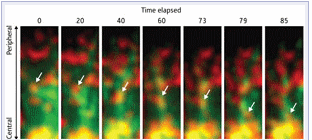기술동향
Keeping the immune system on track
- 등록일2011-10-11
- 조회수5443
- 분류기술동향
-
자료발간일
2011-10-07
-
출처
Riken Research
- 원문링크
-
키워드
#immune system
Keeping the immune system on track
Specialized motor proteins help control immune activation by physically hauling clusters of signaling receptors to a central site for eventual disposal
Specialized immune cells called T cells can recognize threats and induce immune responses through T cell receptors (TCRs), but these receptors do not act alone. Multiple receptors gather together at the cell surface to cooperatively switch on T cells. “The minimum unit for triggering T lymphocyte activation is known as the TCR microcluster [TCR-MC],” explains Takashi Saito of the RIKEN Research Center for Allergy and Immunology in Yokohama. “These are the key structure for T cells to recognize antigens and become activated.”

Figure 1: Following activation, a TCR-MC (white arrow) travels along microtubules of the cytoskeleton (green), making its way from the periphery to the cSMAC (time scale, seconds).
At the interface between T cells and the antigen-presenting immune cells that switch them on, TCR-MCs accumulate at a structure called the central supramolecular activation cluster (cSMAC). Now, research from Saito and colleagues has revealed unexpected insights into how this accumulation occurs1.
Saito and his team were the first to characterize TCR-MC function2, but they were uncertain how these clusters make their way from the periphery to the core of the cSMAC. To understand this phenomenon, they performed a series of experiments in which T cells were placed on an artificial lipid layer that mimics the membrane of an antigen-presenting cell, allowing them to microscopically visualize activation-related events at the T cell surface.
Cellular structures are reinforced by protein fibers that form a network called the cytoskeleton, and Saito and colleagues revealed that TCR-MC movement is mediated by dynein, a ‘motor protein’ that shuttles cargos along these fibers. “We knew lymphocyte activation was regulated through the cytoskeleton,” he says. “But it was most surprising that TCR complexes are physically associated with dynein and that their movement is mediated by assembling with this complex.”
Upon TCR activation, the dynein-facilitated movement drags TCR-MCs laterally along the surface of the membrane towards the cSMAC (Fig. 1), a function previously unseen for this motor protein. Pharmacological inhibition of dynein strongly impaired migration of TCR-MCs and undermined their assembly within the cSMAC, as did the ive reduction of a key subunit of the dynein complex.
Intriguingly, the same treatments that impaired TCR-MC migration also enhanced T cell activation. Saito and colleagues therefore concluded that once these clusters reach the center of the cSMAC, they become internalized within the cell and thereby taken out of action. Saito hopes to exploit this effect by learning how the TCR-MC-dynein complex is assembled. “It would be ideal if we had a specific inhibitor of this assembly,” he says, “which could lead to stronger immune status with enhanced activation of T cells.”
The corresponding author for this highlight is based at the Laboratory for Cell Signaling, RIKEN Research Center for Allergy and Immunology
- Hashimoto-Tane, A., Yokosuka, T., Sakata-Sogawa, K., Sakuma, M., Ishihara, C., Tokunaga, M. & Saito, T. Dynein-driven transport of T cell receptor microclusters regulates immune synapse formation and T cell activation. Immunity 34, 919?931 (2011). article
- Yokosuka, T., Sakata-Sogawa, K., Kobayashi, W. & Hiroshima, M., Hashimoto-Tane, A., Tokunaga, M., Dustin, M.L. & Saito, T. Newly generated T cell receptor microclusters initiate and sustain T cell activation by recruitment of Zap70 and SLP-76. Nature Immunology 6, 1253?1262 (2005). article

